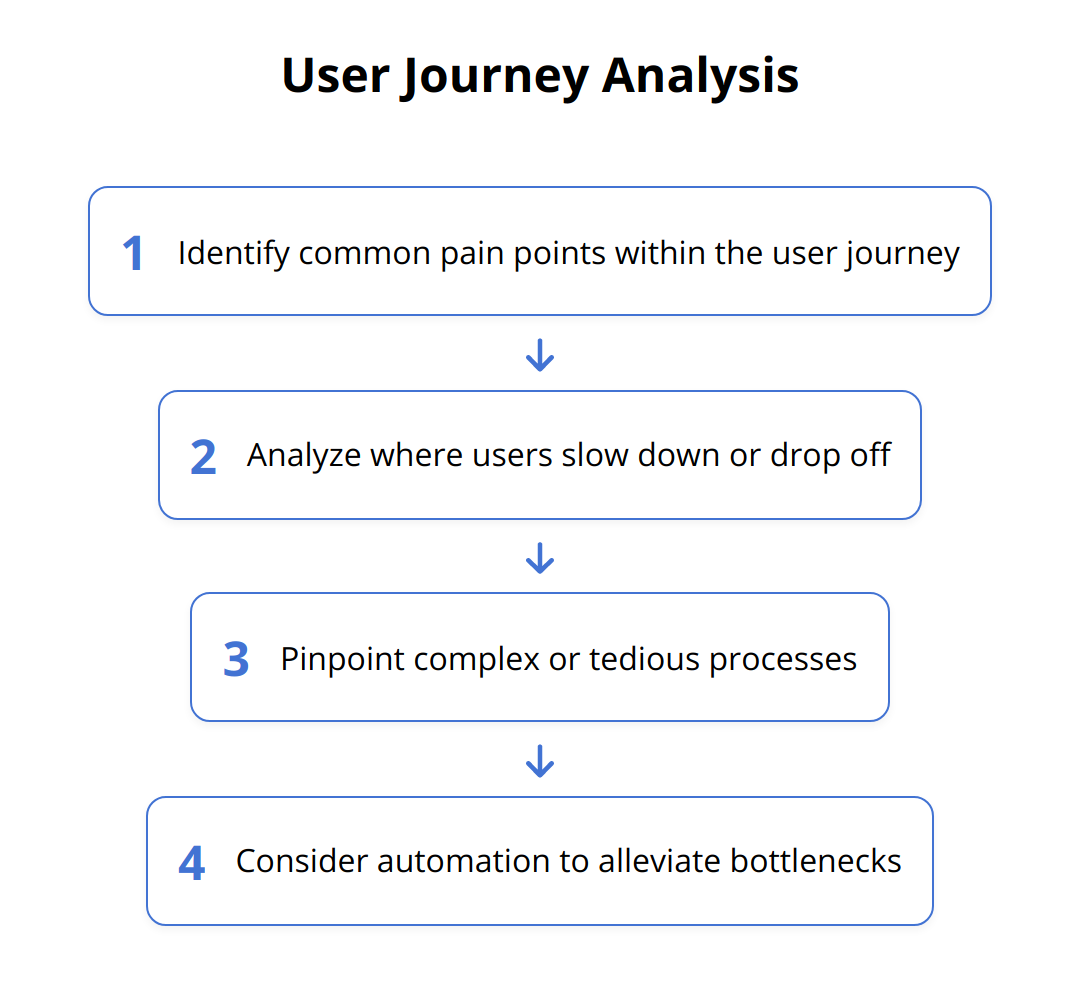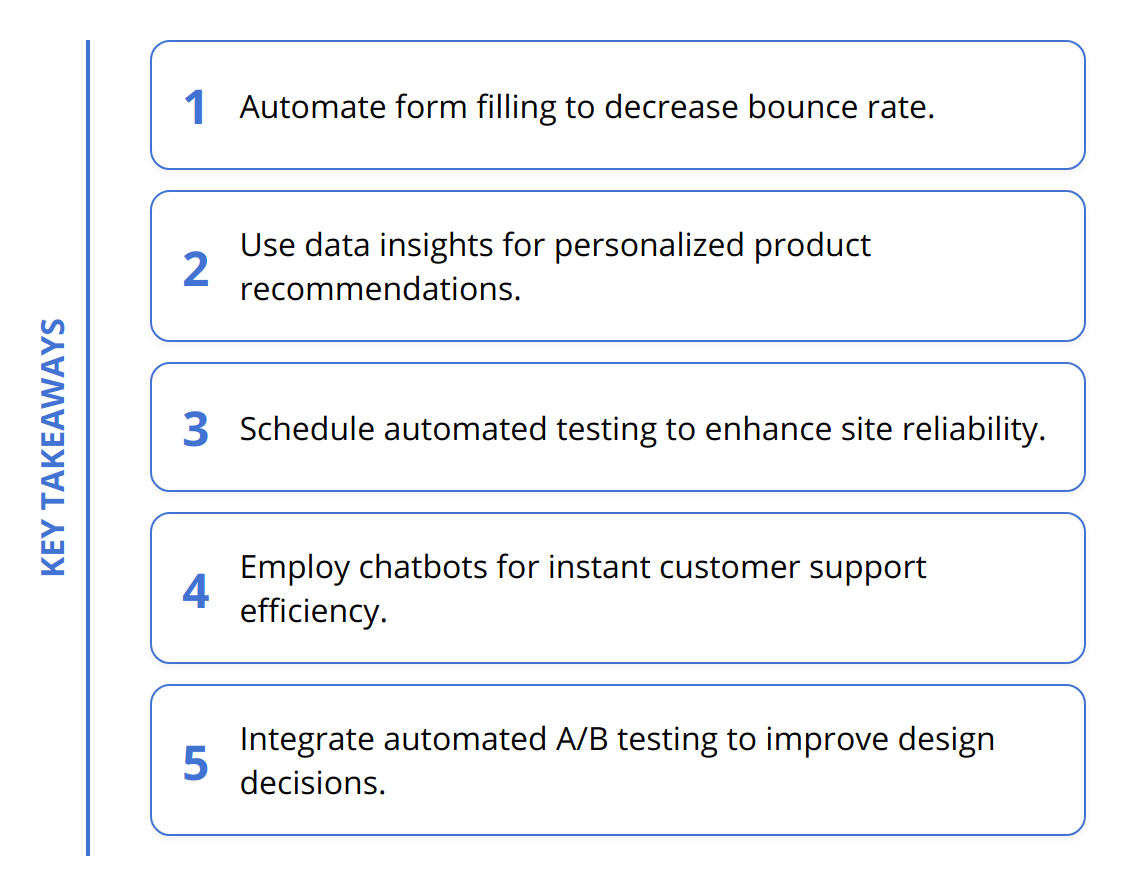In today’s competitive digital landscape, providing a standout user experience (UX) is essential for any website looking to engage and retain visitors. We at Emplibot believe that implementing UX automation is a powerful strategy for achieving this goal. It streamlines interactions, personalizes experiences, and enhances site reliability. Let’s explore the transformational benefits of UX automation and how you can integrate these innovations into your website.
Why Automate Your UX?
User experience automation transforms a website by enhancing efficiency, driving personalization, and bolstering site reliability. Sharp user interactions are no longer a nice-to-have—they are an implicit demand from your users. Websites adopting UX automation see tangible results, like higher engagement rates and improved conversion metrics.
Automating user interactions does more than just save time; it allows for a seamless flow that users appreciate. Consider common tasks such as filling out forms or navigating through a product catalogue. By implementing UX automation, these processes are not just quicker; they become almost invisible to the user, happening with seamless precision in the background. For instance, auto-fill options for forms can significantly cut down on the time a user spends entering information, thus streamlining the whole process. A site’s bounce rate can improve dramatically as a result; in fact, sites that load within 5 seconds see 70% longer average sessions.
Personalization is a game-changer when it comes to user experience. Data-driven automation can track user behavior to tailor the browsing experience to individual needs. Let’s say you’re running an e-commerce platform. By utilizing data insights from past purchases and browsing patterns, you can automate product recommendations that are unique to each visitor. Sites deploying personalized content strategies see a marked enhancement in sales, with a study showing personalized recommendations could lead to an increase in conversion rates by up to 5.5 times.

Lastly, the reduction of human error through UX automation isn’t just about avoiding small mistakes. It’s about delivering consistent quality that users come to expect every time they visit your site. Automated testing, for example, can catch errors before they impact the user, enhancing the site’s reliability and user trust. It was found that automated testing could detect 46% more defects per hour than manual testing, demonstrating not only efficiency but also the ability to maintain a high standard of quality.
In action, these improvements to a website’s UX can be directly linked to bottom-line performance. Consider these practical steps to incorporate automation:
-
Use A/B testing tools to fine-tune automated interactions
-
Implement machine learning algorithms to personalize content dynamically
-
Schedule regular automated testing for different aspects of your site

Remember, user experience automation is not a static process but a dynamic and ongoing journey that keeps you aligned with user expectations and technological advancements. Websites that prioritize automated UX are the ones that will not just survive but thrive in the evolving digital marketplace.
Automating UX: What Are the Benefits?
In a world where digital interactions are rapidly advancing, integrating chatbots and virtual assistants for immediate customer support is not just impressive, it’s expected. These tools serve as the frontline of user engagement, offering instant responses to frequently asked questions and freeing up valuable time for your team to tackle more complex inquiries. For instance, a virtual assistant can handle upwards of 80% of routine questions, according to IBM. By deploying advanced AI like chatbots for customer engagement, your website can not only answer queries but also learn from interactions, becoming more nuanced and helpful with each conversation.

When it comes to navigating the vast array of options on a site, recommendation engines act as a personal stylist for your user’s digital retail experience. By analyzing past behaviors and preferences, recommendation engines curate a bespoke selection of products or content. This is not merely enhancing the user journey; it’s essential for e-commerce success. Amazon attributes up to 35% of its revenue to its recommendation engine. Integrating your very own recommendation system can be a leap towards significantly higher sales and customer satisfaction.

Moreover, automated A/B testing is no longer optional for those serious about design efficiency. The era of guessing what your users prefer is over. Through automated A/B testing, decision-making becomes data-driven, ensuring design choices resonate with your audience and lead to concrete outcomes. Google reported that A/B testing on the color of a CTA button increased click-through rates by 21%. Imagine applying this approach across all your site elements – the cumulative impact can be astounding.
Briefly, the key benefits you’ll see with UX automation include:
-
Improved First-contact Resolution: Bots handling simple queries increase satisfaction and efficiency.
-
Higher Engagement and Retention rates: Tailored content keeps users coming back for more.
-
Data-driven Decisions: Continuous A/B testing refines the user experience, leading to higher conversions.
Embrace technology that tailors the browsing experience to user needs, and your website will be more likely to convert visitors into customers, time and time again.
Pinpointing Automation Opportunities
To boost your website’s user experience, pinpointing where to implement automation is fundamental. Effective UX automation isn’t about using a blanket approach; it’s about targeting key points in the user journey where technology provides the most value.
Uncovering User Journey Bottlenecks
The first step in deploying UX automation is thoroughly analyzing your website’s user journey. Identify stages where users typically slow down or drop off. These bottlenecks could range from a complex checkout process to a tedious account setup. Addressing these areas with automation not only enhances the user experience but also smoothens their path toward conversion.

Selecting the Ideal Tools for Automation
Once areas for automation have been identified, the next step is selecting the right tools. The choice of tools should align with your website’s specific needs and objectives. For e-commerce sites, for instance, revising your checkout flow with an automated payment processing tool can slash cart abandonment rates. When considering content personalization, machine learning platforms can dynamically adjust website content to suit user interests, as found in our guide on implementing marketing automation.
Tailoring and Tweaking Automation
Rolling out automation is only the beginning. Continuous monitoring and iterative adjustments ensure that automated elements are meeting user needs. Keep a keen eye on metrics such as engagement rates and feedback loops. Incorporate user feedback to refine and optimize automated processes. Tools that allow A/B testing can be particularly beneficial in evaluating different automation strategies and selecting the one that performs best.
For robust reliability and efficiency, consider these actionable insights:
-
Detailed Analytics: Leverage analytics to detect friction points in the user journey.
-
Strategic Tool Selection: Adopt tools that refactor time-intensive tasks.
-
Data-Informed Adjustments: Use user feedback and performance data to fine-tune automations.
By tackling UX automation with a strategic, data-informed approach, your website can deliver an enhanced user experience that not only retains users but also converts them consistently. Keep evolving with user preferences and technological advancements to remain a cut above the rest.
Wrapping Up
Automation is revolutionizing user experience on websites, making interactions effortless, personalizing user journeys, and ensuring consistently high-quality engagements. By integrating smart, data-driven UX automation, websites are seeing a substantial uplift in user engagement and conversion rates, painting a clear picture of how automation can elevate the digital experience.

A balanced approach to automation, one that enhances rather than overwhelms, is pivotal. It’s vital that websites maintain a human touch where it matters most, ensuring that while many processes are automated, the overall experience feels personal and thoughtful. This careful balance is what sets apart a good user experience from a great one.
We at Emplibot are passionate about leveraging technology to bolster your website’s content strategy. With a tool like Emplibot, you can keep your blog fresh and engaging with SEO-friendly articles published automatically, driving your content marketing forward without the need for constant hands-on effort.
Embrace continuous innovation and user-centric design to stay ahead in the digital space. By doing so, you assert your commitment to providing an exceptional user experience—one that is seamless, sophisticated, and always evolving with your audience’s needs.
Remember, automation is not the destination but a journey—a journey towards a more intuitive, user-focused web. Take the initiative and harness the power of UX automation to deliver a superior online experience, one that users will return to time after time.

